HOME
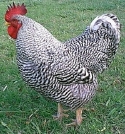
~~~Throughout this site, simply hover your mouse over each picture for a pop-up caption to explain what or who it is.~~~
The Coop And Run
COOP
I've always said that the chicken motto (or mantra) is: "If it's possible
for a chicken to hurt itself on something, somehow it will find a way to
do it." This means that when you build a coop you should literally get down
at chicken level and use your eyes and hands to seek out sharp points, dangerous
wire edges, loose bits of wire to get tangled in, etc. This simple procedure
can save you a lot of grief and vet bills. It's ridiculous how often and how
quickly chickens can get into trouble, just like a two year old human child--which bears repeating,
is a birds' basic intelligence level. They have the curiousity of a two year
old as well! To illustrate this, as I type this, Yin, one of my hens--this one
is 7 years old and you'd think she'd know better--just jumped up on the edge
of a tall cardboard box that I had on the porch and fell inside. I had to
go outside and rescue her...
In building the coop, at our house we use hardware cloth--the sturdy metal
welded wire fencing with the small, square holes--instead of chicken wire.
Chicken wire is too flimsy and the holes are too large, NEVER, EVER USE CHICKEN WIRE. I cannot stress this strongly enough. Also, chicken wire rusts and becomes brittle with age, and predators can tear through it like tissue paper. A good test is to see if YOU can tear down your run with your bare hands--and really TRY, because that neighbor's dog sure will! If you can get through, so can a predator. Make it strong. You should build
your coop not only to keep your chickens (and baby chicks!) IN, but to keep
predators OUT. Baby chicks can easily slip right through the holes in chicken
wire, and small animals that might carry disease like mice, rats and sparrows
can slip in. Rats and mice can flatten themselves out to slip through VERY small spaces--if their head can fit through a hole, so can the rest of their body! Also larger predators can easily break though chicken wire or,
as in the case of raccoons, reach their little hands through the wire to
grab and kill one of your birds and eat them by the handful right through
the wire. The classic raccoon attack is a chicken with it's back eaten out-- sometimes the bird survives, suffering horribly from this gaping wound. I've heard many stories of chickens found dead in a tightly locked
up coop where this has happened, especially if they are young birds and are
sleeping next to the wire, like mine were doing in this picture. They were two month old youngsters, newly added to the flock, and insisted on sleeping in one big pile, jammed between the back of the nest boxes and the coop wire wall. If this wire were chicken wire, they would be easy prey to a predator!
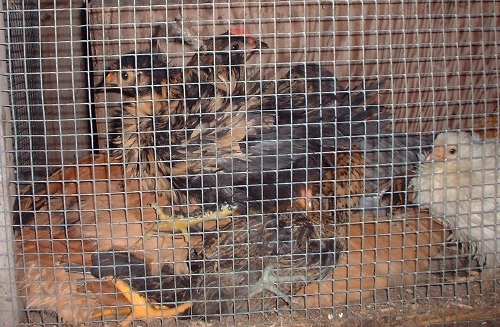
Chickens sleep pretty soundly at night and have
poor night vision. Also, chickens being a prey animal, they display the prey animal trait of seeming to just give up, go into a trance and accept their fate the moment they feel a predator has them and they cannot get away.
Also when building the coop, make sure to extend the fencing 4-6 inches BELOW
ground, and bend it outward. This keeps predators from simply digging under
the wire and into the coop from the outside, which is VERY common. Do not skip this step!. The door to the coop should
have very secure latches--we use TWO bolt-style latches. One
is at human eye level, the other is about 6 inches above the bottom of the
door. This is so a ground-based predator like a raccoon can't just
grab the bottom of the coop door and pry it open enough to get inside. Also a common problem, and not to be skipped.
Test your coop door by grabbing it at the top, middle and bottom and pulling--if
you can pry open a rat or mouse-sized access point, so can a predator!
Most predators are VERY determined, clever, strong and patient. Your coop door
should be very sturdy and strong enough to hold up to lots of use.
Even better is a set of double doors or aviary doors--you go through the
first one into a small chamber and must shut the first door before opening
the second into the coop. You see these in aviarys in zoos all the
time, it prevents unauthorized birdy escapes. Make sure to build your
coop to withstand the weather extremes for your area--make heating or cooling
arrangements if your climate requires. Chickens are tough, but after all are still birds, and birds are delicate and easily injured.
Chickens can get too overheated and die, so in hot areas a mister system,
water bottles that have been frozen and then placed in the run as a cool
spot or just plain old YOU with a garden hose all work great to cool them
off. If you hang old burlap sacks at chicken level on the wire sides
of the coop or run and hose them down, the birds are cooled by evaporative
cooling. In our hot southern California summers, I go out every two hours at MOST (more often if it is really hot) and hose off the plants, ground--whereever the chickens like to hang out in the shade--and the chickens themselves. It won't make you popular but it keeps them alive. On a hot day, if a chicken is standing with it's feathers slicked down, wings held open and panting, its overheated and needs to be cooled off NOW. I just put a pressure nozzle adjusted to a nice spray on my hose and mist everyone off really well. In cold weather areas some chicken owners install a light
bulb that they leave on to help ward off too-cold temps. Chickens with large combs and wattles, such as Leghorns, can sometimes suffer frostbite in freezing temperatures. You can either plan ahead and only have birds with pea or rose combs, or apply a thin layer of Vaseline (petroleum jelly) daily to the birds' comb and wattles to help insulate them from the cold.
ROOSTS
Adequate roosts should be placed--we use squared off 2 x 2 poles that we
have sanded lightly to remove splinters and round off the edges a bit for comfort for all our birds, both standard and bantams. Provide
plenty of roosting space to lessen bedtime squabbles over who sleeps where. You can use a ladder-type of roost or a single level, or several roosts scattered in various places. If it gets very cold, consider having a single roost area where the birds have to huddle together, it will help eliminate single birds freezing the death or getting frostbitten. Your birds will instinctively want to go to the highest point to roost, so the upper roosts may be squabbled over. We use a single level roost with 4-5 long roost poles.
NESTS
Nests should also be plentiful, provide a nice darkened hidey-hole type feeling
and have an adequate layer of nesting material such as straw. I recently spoke
to someone whose hens refused to lay in the nest boxes--until she added another
inch of straw to them! A good nest will reduce the chances of your hens 'laying
away'--that is, finding or creating their own nest elsewhere. If your
hens are fighting over certain nests, create a few more spaced away from each other,
that way the bullies can't be everywhere at once to guard them all.
QUARANTINE, BROODY HEN PENS AND INJURED BIRD PENS
It's a REALLY good idea to have at least a seperate, small enclosure for sick or injured birds, at the very least. Because sooner of later you'll have one, at the most inconvenient time possible. It's best to build it so the bird can remain in it 24/7, so it needs to be secure at night. Anything other than a contagiousor quarantined bird can have a separate run built right into your existing coop or run, you can skip the burying wire step since it will already be inside your secure coop/run. This is great for injured birds and broody mamas with chicks, that way they are around the flock but safe from bullies.
Sick birds or new birds to your flock that you are quarantining are another matter. You need to be prepared for this and be ready to either bring them into your house or garage, or build them a secure pen AWAY from your flock and where your flock cannot get near them in case they might catch whatever illness your sick bird has. Your quarantine/sick pen MUST be secure, complete with buried wire.
CLEANING AND SANITIZING THE COOP
One handy tool for keeping your coop, roosts, nest boxes and food-water containers clean, disinfected and practically mite and pest free is a hand-held steam cleaner. I use one made by Scunci, pictured here. Here is a link to their site,
which provides more info. I have no affiliation with Scunci in any way, I just use the product and it works great, especially as a pesticide-free and organic way of killing mites! Pests can't develop a resistance to 'death
by heat' like they can to pesticides, so this is a great option. Needless to say, DO NOT USE THIS ON YOUR BIRDS, IT WILL GREATLY HARM OR KILL THEM! Use it on the coop, living quarters and emptied food and water containers only, please. Also, ONLY use water in the cleaner, never any chemicals or anything else--you don't want to risk an explosion or aeresolizing harmful chemicals for you and your animals to breathe. Follow the manufacturer's directions to the letter and stay safe.
http://www.scunci-steam-cleaner.com/
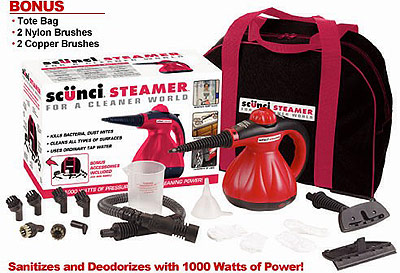 When I use my cleaner I fill it as directed--be respectful of steam, steam burns HURT and are serious, and keep the cleaner AWAY from children and animals. Wear a mask when using it to avoid breathing in vaporized chicken poop and dirt. The outside of the cleaner does get warm, so use care.
This little cleaner is very portable and comes with a storage bag, several nozzles, a brass brush or two and a flexible hose. It's great for softening and blasting off dried chicken poop (which normally has the consistency of concrete) and getting deep into
the nooks and crannies of the roosts and nests. If you use it on food and water containers, empty them out and scrub them off first--you must remove any debria such as poop, algae, etc. before the steam can do it's job. If you are trying to disinfect an area, no matter WHAT type of disinfecting tool or chemical you are using, chicken poop MUST be removed in order to get the area
under it clean, otherwise you are wasting your time. Chicken poop traps and harbors mite and worm eggs and adults. The combination of the steam cleaner and a scraper where needed is an unbeatable team when
it comes to coop cleaning. Since this cleaner uses steam, it doesn't badly soak the wood and things dry out quickly.
When I use my cleaner I fill it as directed--be respectful of steam, steam burns HURT and are serious, and keep the cleaner AWAY from children and animals. Wear a mask when using it to avoid breathing in vaporized chicken poop and dirt. The outside of the cleaner does get warm, so use care.
This little cleaner is very portable and comes with a storage bag, several nozzles, a brass brush or two and a flexible hose. It's great for softening and blasting off dried chicken poop (which normally has the consistency of concrete) and getting deep into
the nooks and crannies of the roosts and nests. If you use it on food and water containers, empty them out and scrub them off first--you must remove any debria such as poop, algae, etc. before the steam can do it's job. If you are trying to disinfect an area, no matter WHAT type of disinfecting tool or chemical you are using, chicken poop MUST be removed in order to get the area
under it clean, otherwise you are wasting your time. Chicken poop traps and harbors mite and worm eggs and adults. The combination of the steam cleaner and a scraper where needed is an unbeatable team when
it comes to coop cleaning. Since this cleaner uses steam, it doesn't badly soak the wood and things dry out quickly.
THE CHICKEN RUN
Even if you have a large yard, you may also want to build a run for your birds. Runs are handy if you are going out of town for a few days and want them to be secure, but still have a larger area to roam in, without it being open to predators. You friend or family member who comes over to feed the birds in your absence will appreciate it, too, so they don't have to worry about getting the birds back into the coop at dusk. Runs are also great for protecting against bad weather. Here's mine:
After many months of building, the new chicken run is finally done and housing the chickens nicely! Here are two pictures of the old coop before:
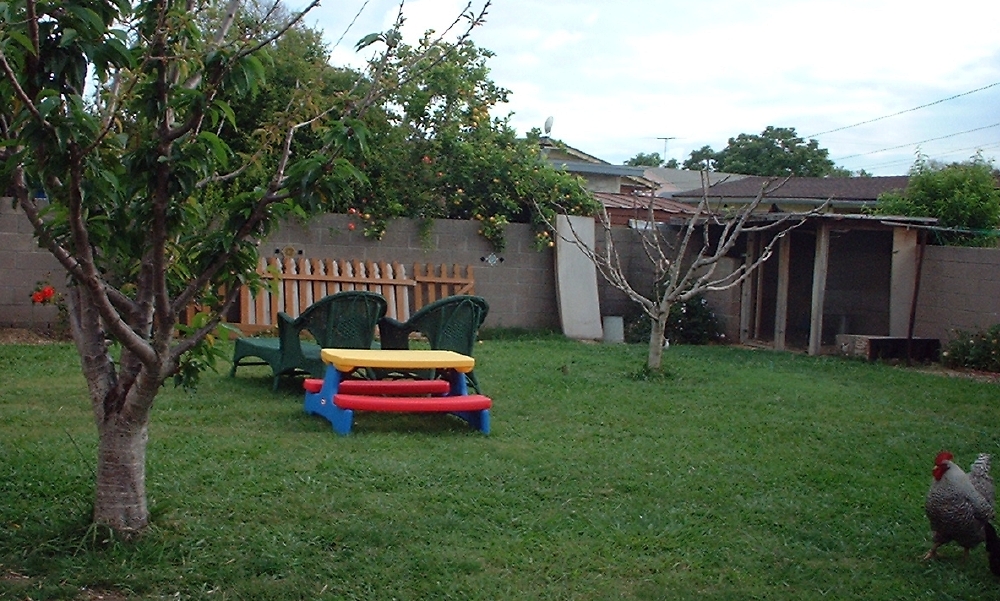
And the area where the new run was attached to the existing coop, which was left in place.
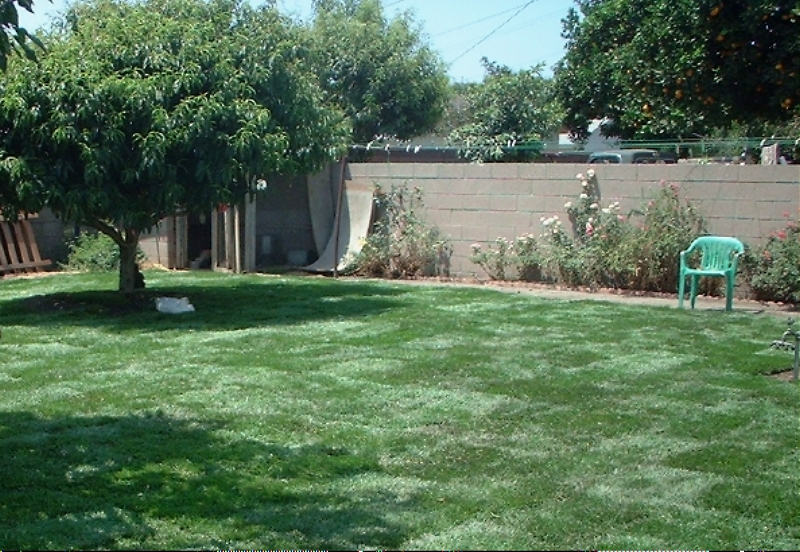
I had to give up my clothesline area temporarily.
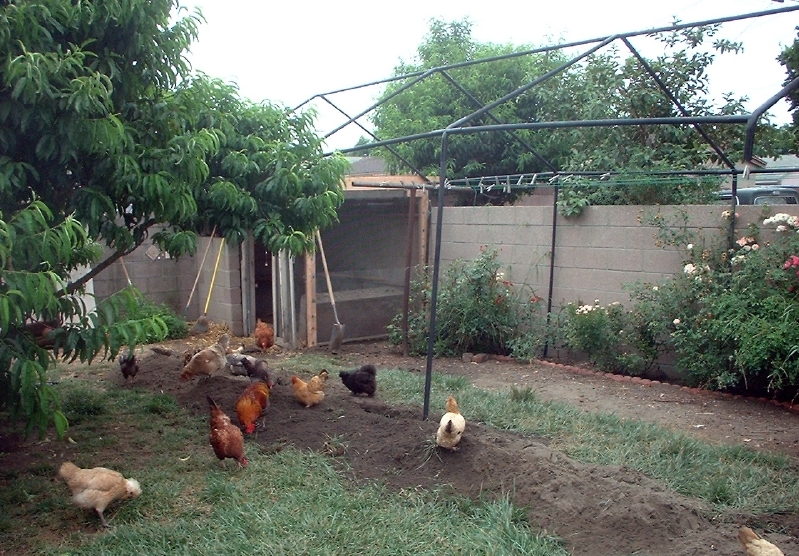
The new run's framework is tubular steel, which used to be a canopy over our patio. A windstorm pretty much took care of the canopy one night, leaving the steel skeleton. So we recycled it!
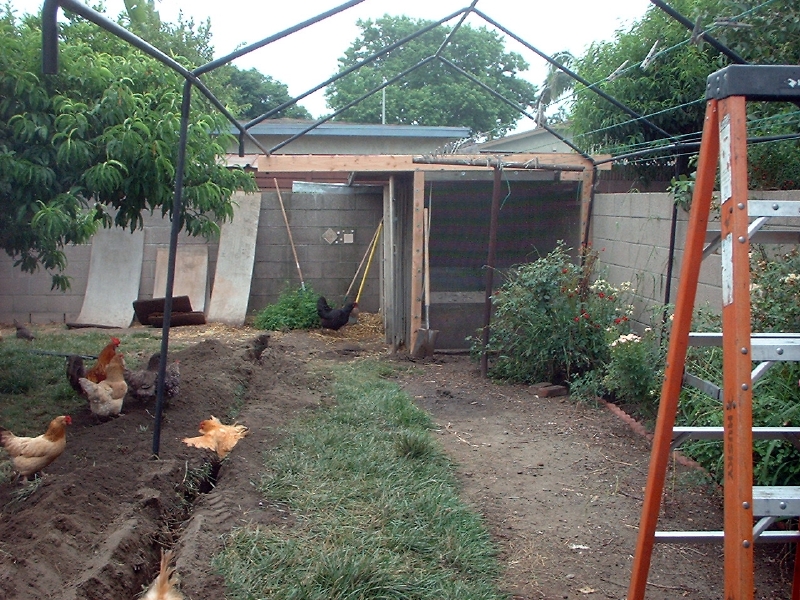
Unfortunately one of our elderly little bantam hens, Chicken Sister (she used to have a twin sister, hence her name) in this shot has fallen into the trench we dug to bury the hardware cloth below ground in. She was looking over her shoulder at me taking the picture when she SHOULD have been watching where she was going. This is her doing her impersonation of a chicken pancake, poor baby. Only her dignity was hurt, though.
Everyone enjoyed the freshly dug dirt, to a chicken this is irresistable.

The hardware cloth going up...
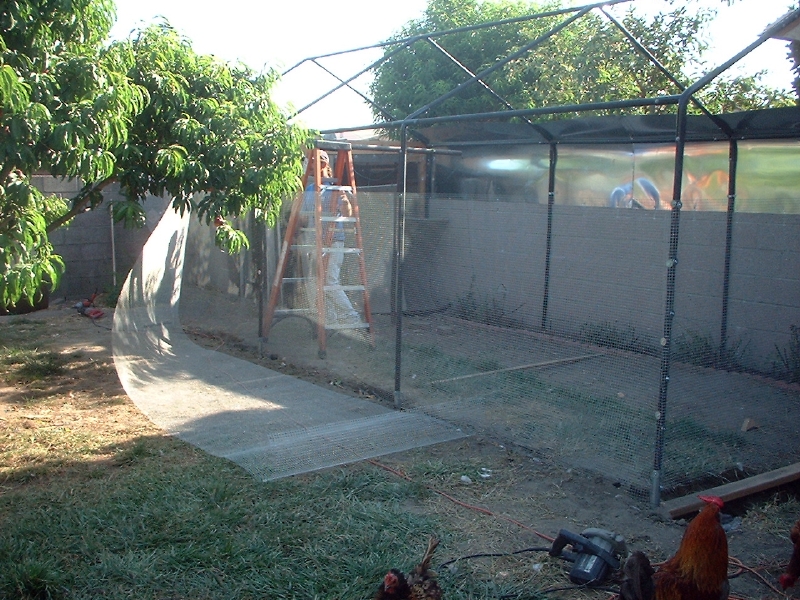
...and the doorway is framed in. Sheet metal connects the existing cinder block fence to the canopy framework. We didn't use wire here in order to reduce drafts.
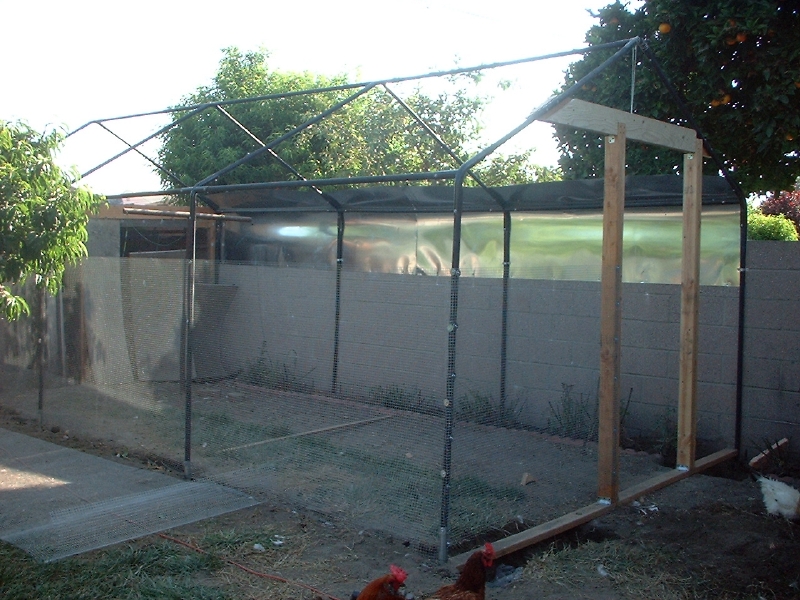
The corrugated steel roof going on. J. used steel 2x4's and sprayed in expansion foam to help seal any openings.
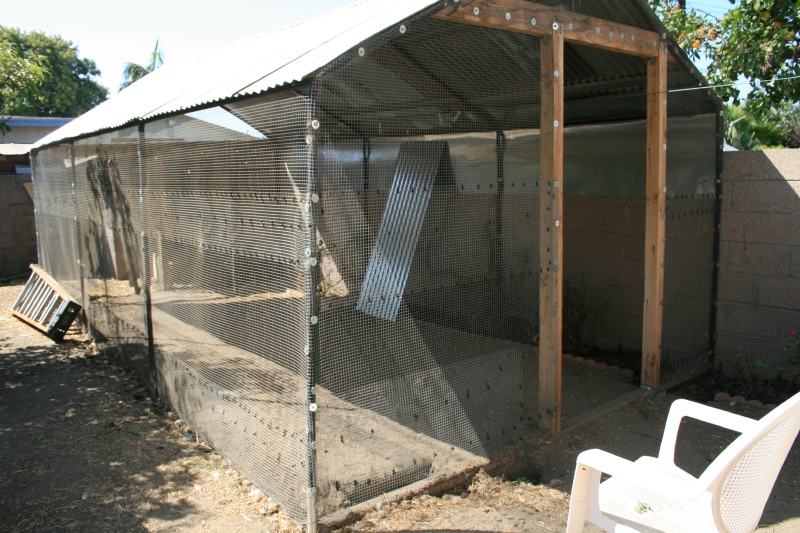
The view from the inside. Where the sheets of hardware cloth met, J. overlapped them by several inches and I secured the gaps with UV resistant heavy duty zip ties to keep out rodents, possums, etc.

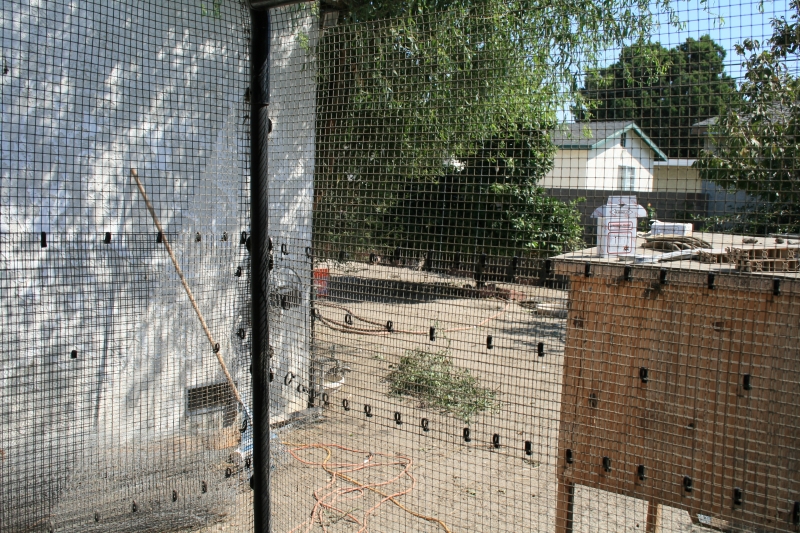
A better look at the sheet metal, which was bolted to the cinderblock fence.
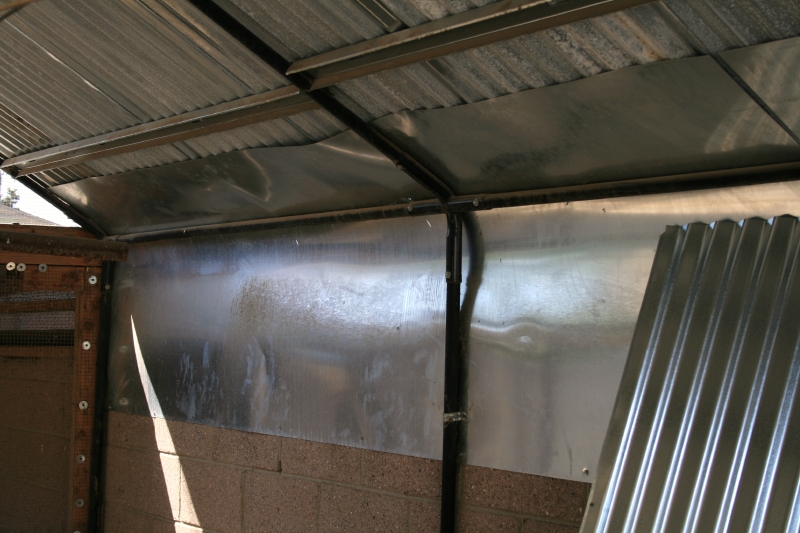
The interior of the roof, steel 2 x 4s were staggered.
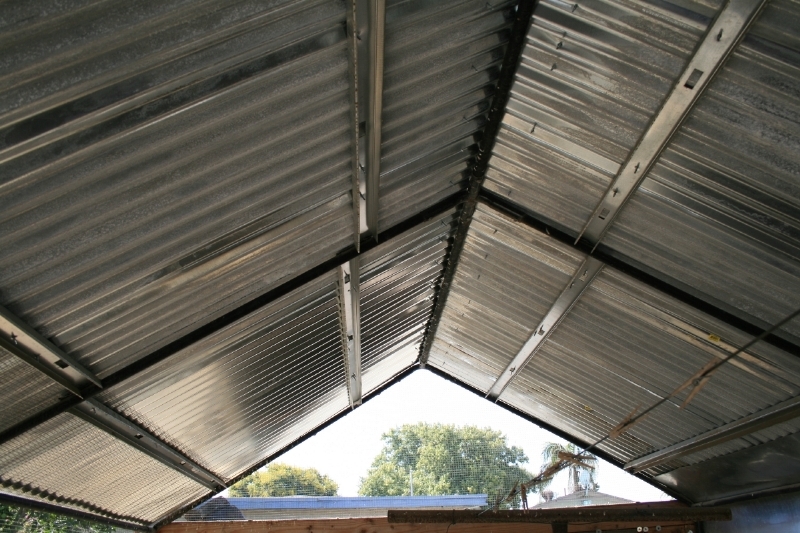
Inside again, looking towards the old coop. We left the old coop as it was and just removed a wire panel off the front of it to create the opening into the new run. The old coop door we closed securely and left as it was.

A better view of the old coop opening and how old and new connect to each other.
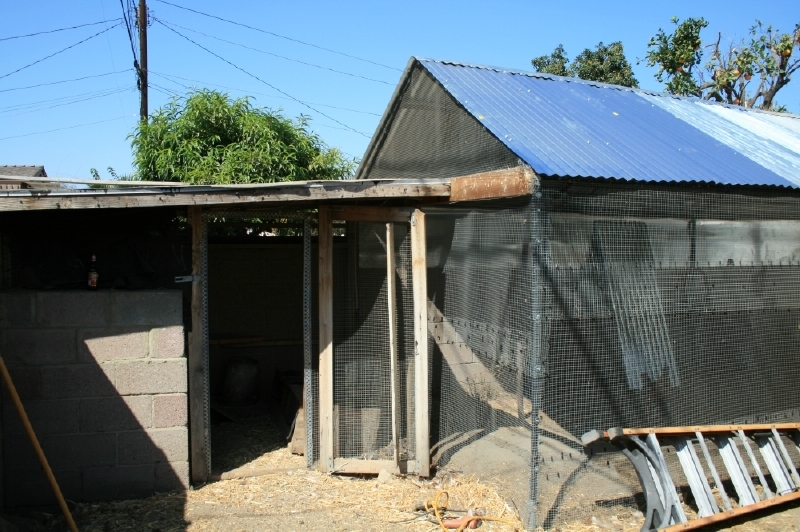
The wire panel removed and the nest boxes rearranged. You can see the expansion foam in place in the ceiling. Even my daughter's bunny had to check it out!
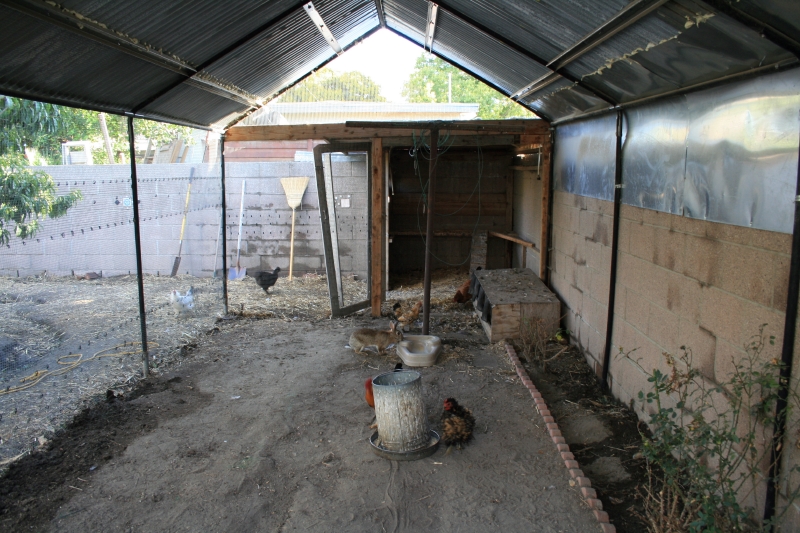
Done!
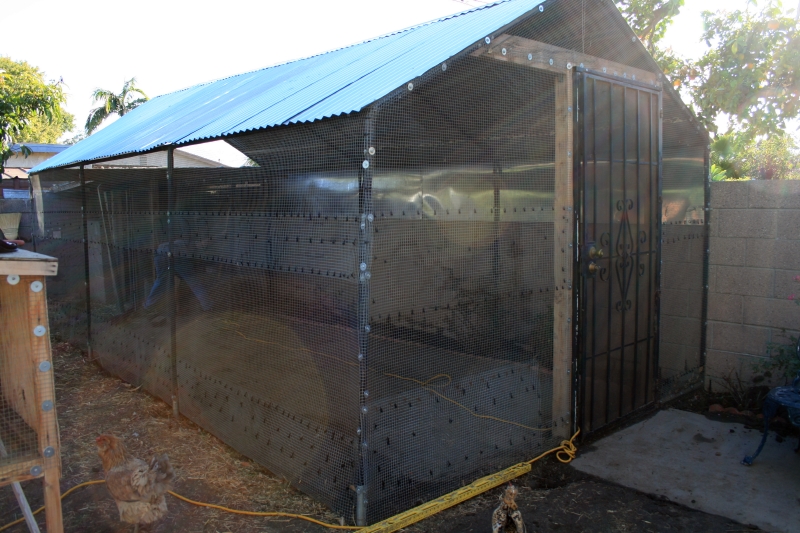
For the new door to the run, J. found two identical, perfectly working steel security doors, with locks, keys and doorway framing, sitting curbside one day. Perfect for chicken coops! There is one more door, which will be installed soon when we attach an 'aviary door' to the run. Aviary doors are just a set of two doors set a few feet from each other, so one is always closed before the other can be opened--it prevents escapes of birds and helps keep predators out. J. is installing a new clothesline for me, it will fit inside the run and stretch from one end of the run to the other. The big metal T stands for the old clothesline we just left. Several banty hens have fallen in love with the one inside the run anyway, and perch on it at night.
CHICKEN TRACTORS
Despite that very fun little mental image you have, a chicken tractor is NOT a miniature John Deere with a big rooster at the wheel. :)
A chicken tractor is a small, low, long enclosed chicken run designed to hold anywhere from 2-7 (on average) chickens. It is made of a sturdy wire and has an open bottom, and can be dragged from one spot to
another in the yard so that the chickens can scratch and dig, eat bugs, fertilize and weed different patches of ground--hence the 'tractor'. Tractors are lightweight so that even women can move them, and some have
small, wooden-sided coops and nest boxes attached (with solid bottoms), and even wheels on the bottom to facilitate moving them.
Make sure to keep your chicks VERY well protected in the tractor, predators are VERY patient and clever about getting a chicken dinner, especially at night. Chicken tractors, by design, are meant to be daytime runs
ONLY and are NOT secure enough to withstand an attack by a predator. Predators are adept at tunneling under wire and reaching through it, or just plain ripping through things like chicken wire, which is NOT
designing to keep chickens safe. Chicken wire is designed to keep chickens out of gardens, and is NOT strong enough to protect your birds from any predator. To make matters worse, chicken wire quickly becomes
brittle when exposed to the elements. So if you build your own chicken tractor, PLEASE use only the best and sturdiest materials--hardware cloth for example and NOT chicken wire--and always securely coop your
birds from dusk to dawn. The wooden, solid-side and bottom coops are also there because your birds need to be IN THERE when you move the tractor. This is because you generally lift one edge of the tractor to
drag it along, and chickens still in the run can either escape or get caught and injured under the moving edge of the tractor. Remember The Chicken Motto? If you build your tractor, one thing to take into
consideration is that at some point, it is very likely you will need to get YOURSELF into the tractor to go after a trapped, injured or sick bird. Leave yourself some crawling room. :) It's also another reason to have
tame birds that are accustomed to being picked up and held or petted. If you are planning to raise chicks--and don't fool yourself, you WILL, once you fall in love with your chickens--make sure to include in your
design a way to partition off mama and the new chicks so they don't get attacked by the other birds. There is no way to tell from one hatch to the next if this will happen, but in a small space like a tractor there is less
room for mom and the kids to escape, so plan ahead. Either that or build a seperate tractor for the broody and chicks to be SURE they are safe. A seperate area AWAY from the flock is also a good idea to have
handy for sick or injured birds, which, inconsiderately enough, they never schedule in advance. So be ready. :)
There are plenty of sites and plans online for chicken tractors, you can also search on 'permaculture' and 'hoophouses' for more results and how-to's, and searching Google Images returns loads of great pictures and
plans. There are several sites with terrific chicken tractors for sale, here are a few:
Great article not only on chicken coops and tractors, but on people in urban areas keeping a few hens:
http://seattletimes.nwsource.com/pacificnw/2002/0120/cover.html
The Omlet site, they sell pre-fab chicken tractors called Eglus (they even come with two hens!), give the site a read, it's HIGHLY entertaining and fun, and the Eglu design is fantastic:
http://www.omlet.co.uk/homepage/homepage.php
copyright 2003-2013 by Velvet Sparrow

 When I use my cleaner I fill it as directed--be respectful of steam, steam burns HURT and are serious, and keep the cleaner AWAY from children and animals. Wear a mask when using it to avoid breathing in vaporized chicken poop and dirt. The outside of the cleaner does get warm, so use care.
This little cleaner is very portable and comes with a storage bag, several nozzles, a brass brush or two and a flexible hose. It's great for softening and blasting off dried chicken poop (which normally has the consistency of concrete) and getting deep into
the nooks and crannies of the roosts and nests. If you use it on food and water containers, empty them out and scrub them off first--you must remove any debria such as poop, algae, etc. before the steam can do it's job. If you are trying to disinfect an area, no matter WHAT type of disinfecting tool or chemical you are using, chicken poop MUST be removed in order to get the area
under it clean, otherwise you are wasting your time. Chicken poop traps and harbors mite and worm eggs and adults. The combination of the steam cleaner and a scraper where needed is an unbeatable team when
it comes to coop cleaning. Since this cleaner uses steam, it doesn't badly soak the wood and things dry out quickly.
When I use my cleaner I fill it as directed--be respectful of steam, steam burns HURT and are serious, and keep the cleaner AWAY from children and animals. Wear a mask when using it to avoid breathing in vaporized chicken poop and dirt. The outside of the cleaner does get warm, so use care.
This little cleaner is very portable and comes with a storage bag, several nozzles, a brass brush or two and a flexible hose. It's great for softening and blasting off dried chicken poop (which normally has the consistency of concrete) and getting deep into
the nooks and crannies of the roosts and nests. If you use it on food and water containers, empty them out and scrub them off first--you must remove any debria such as poop, algae, etc. before the steam can do it's job. If you are trying to disinfect an area, no matter WHAT type of disinfecting tool or chemical you are using, chicken poop MUST be removed in order to get the area
under it clean, otherwise you are wasting your time. Chicken poop traps and harbors mite and worm eggs and adults. The combination of the steam cleaner and a scraper where needed is an unbeatable team when
it comes to coop cleaning. Since this cleaner uses steam, it doesn't badly soak the wood and things dry out quickly. 














